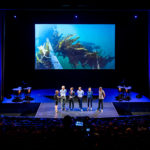
Yet until recently there was no large-scale, cross-disciplinary scientific meeting dedicated to this health crisis. While there were other big-tent meetings organized around chronic health conditions, such as the American Heart Association’s and the American Diabetes Association’s Scientific Sessions conferences, obesity meetings had tended to remain narrow and specialty-focused. On the basic-science side, Silver Spring, Maryland–based The Obesity Society (TOS) hosted an annual meeting that gathered scientists for programming and discussion of the latest obesity findings. On the clinical side, the American Society for Metabolic & Bariatric Surgery (ASMBS), headquartered in Gainesville, Florida, held its own scientific and educational meeting for physicians and health-care providers interested in advancing the science of obesity surgery.
Within each organization, there was acknowledgment that obesity is a disease that crosses many fields of study and requires a multidisciplinary-treatment approach. Consequently, both TOS and ASMBS had been expanding the programming at their annual meetings to accommodate more tracks and additional cross-disciplinary sessions — and both had experienced growth in the number of non-member attendees who didn’t specialize in obesity exclusively but whose practice or research intersected with the disease.
It wasn’t such a leap, then, when ASMBS leadership approached TOS in 2008 about creating a meeting that would bring together all the key organizations interested in obesity. Toward the end of that year, TOS and ASMBS committed to co-locating their annual meetings — with the goal of creating the largest, most important scientific meeting covering all aspects of obesity. “We made a decision to join our annual meetings,” said Georgeann Mallory, ASMBS’s executive director, “so we could provide education that would cover the full scope of the obesity issue, from cutting-edge basic science and clinical research to intervention and public policy.”
The result was ObesityWeek, which debuted to rave reviews at the Georgia World Congress Center (GWCC) in Atlanta last November. With five days of programming, a variety of interdisciplinary tracks, and joint sessions for networking and discussion, ObesityWeek offers a case study of how medical associations can join forces to more fully and effectively confront a public-health crisis.
THE BACK STORY
Making the Decision to Co-Locate
TOS has a membership of about 2,500 — a mix of Ph.D.s, physicians, and registered dietitians. ASMBS’s membership is about 4,000; half are surgeons, while the rest are nurse practitioners, advanced practice nurses, dietitians, and other allied health professionals. Prior to 2013, each organization’s annual meeting averaged about 2,300 attendees.
Approximately 10 percent of each group’s membership belongs to the other organization, and there was already some overlap in programming when TOS and ASMBS started discussing co-locating. “Our two organizations represent the entire scientific spectrum,” said Martin Binks, Ph.D., associate professor of nutritional sciences at Texas Tech University and secretary/treasurer of the TOS Council. “Our hope was that by putting them in the same building and giving everyone access to both meetings, we would encourage more trans-disciplinary crosstalk and improve collaborative potential.”
Another hope was that co-locating the meetings would raise their profile and establish ObesityWeek as the go-to source among the larger research and medical community. “There are so many physicians and scientists outside of our membership who are touched by obesity,” said Francesca Dea, CAE, TOS’s executive director. “We wanted to grow the meeting so that when those professionals were looking for a place to get more info about obesity, this would be it.”
On a more practical level, the possibility of economies of scale and increased revenue further made the case for co-locating, but both organizations were cautious. While they signed a memo of understanding in late 2008 and formed a legal unit, ObesityWeek LLC, to manage finances for the event, it took another year for them to approve the mission statement and structure. “You can imagine how fearful you are when you decide to make a radical change to two meetings that have existed separately for 30 years,” Binks said. “Our worst fear was, this is a really bad idea and people won’t show up.”
To head off that worst-case scenario, TOS and ASMBS embarked on a four-year messaging campaign, led by a joint marketing subcommittee, to educate members about ObesityWeek and also uncover any concerns, so they might be addressed in the planning stage. “Our members and attendees were exceptionally favorable, but we attribute some of that to a four-year communication campaign about ObesityWeek,” Dea said. “We started communicating about it in 2010 and never stopped communicating the value of us coming together and co-locating.”
THE MANDATE
Maintain Individual Identities
From the earliest planning meetings, both organizations made clear that maintaining their own identity and culture was a priority. Immediately, the decision to use the term “co-locate,” rather than “merge,” established that attendees would not have to sacrifice their own organization’s meeting to participate in the expanded event. “When we first introduced the idea to our membership, the biggest fear was these had both been fairly intimate, smaller meetings, and both had a longstanding history where you go and know everybody,” Binks said. “The concern was we would lose the unique culture of the individual meetings.”To ensure that didn’t happen, each meeting’s program committee maintained its own submission and review process, while a joint ObesityWeek Board of Managers worked to ensure there was an appropriate balance of joint activities and TOS- and ASMBS-specific sessions. “It was very important to both our organizations to maintain our autonomy and the type of programming that our attendees traditionally enjoyed,” Dea said. “We wanted to maintain that semblance of normalcy, while at the same time expose them to something entirely new.” As a way of emphasizing that point on site, ObesityWeek 2013 held TOS sessions on one floor of GWCC and ASMBS sessions on another. (Keynote sessions and the exhibit hall were common programs, and attendees could attend sessions at either meeting.) Binks said: “It created a sense of, here’s my regular meeting, but then I just cross the hallway and I can go to all these great joint things.”
Both organizations also maintained chapter and interest-group social events, giving members additional opportunities to interact with their peers. “Our interest groups have always hosted events — lunch, happy hour, etc.,” Dea said, “and so we made certain to maintain those, and also offered additional support if some of the sections who had done less in previous years wanted to do a little bit more in 2013.” ASMBS likewise maintained small-group events for its attendees. “We had some smaller receptions, and we’re looking at having a couple more this year,” Mallory said. “It’s nice to have some smaller events where you know you’re going to run into your ‘peeps.’”
THE DETAILS
‘We Had to Compromise on Every Little Thing’
When TOS and ASMBS began working on ObesityWeek 2013 four years out, they thought they were being very conservative with the time allotted for planning. In reality, the work involved far exceeded all expectations. “That old saying ‘the devil is in the details’ had great meaning for us in the planning stages,” Mallory said. “Both ASMBS and TOS had well-established and successful meetings, but in coming together, there were no longer any established protocols. We were starting from scratch. Everything down to the most minute detail was a decision on which both organizations had to come to agreement.”
“Everything you’ve done for 30 years,” Dea said, “all the traditions and all the simple things like what your badge looks like, has to be examined and considered. We had to compromise on every little thing. Compromise wasn’t difficult, but it took three to four times as long. I think we had 12 hours of discussion about badges alone. It was tedious, because every little detail is important to one or the other group, and you want to be sure you don’t offend the attendees of either group.”
Dea points to registration as a particularly challenging area to plan and organize. “The registration site is complex enough for an individual group,” she said, “but when you’re putting together two groups, and you have member and non-member rates, and you’re putting together two data systems to coordinate, and how do you handle new registration, it was a challenge.”
Another time-consuming aspect of planning was coordinating food-and-beverage traditions. “ASMBS had traditionally provided a lot more food to attendees,” Dea said. “When we put our meetings together, they couldn’t just take everything away from their attendees, but we couldn’t add all of that. It was a fine balance of meeting in the middle and making it work.” What that meant was that in 2012 each organization made minor changes to its food-and-beverage so the difference in 2013 wouldn’t be so dramatic.
While ObesityWeek’s governing Board of Managers and its numerous subcommittees had considered thousands of details, there were still some surprises and lessons learned when the event finally began. For example, surgeons are used to starting their workday early, so ASMBS’s meeting correspondingly starts early. Researchers, on the other hand, start a little later and like to go a little later, reflecting their academic, all-nighter habits, according to Binks. A day or so into ObesityWeek, TOS leaders realized their member-services desk would need to start keeping surgeon hours if it wanted to connect with ASMBS members.
“Our member-services desk always opened right when the first session began, because we could never see a single member before the first session,” Dea said. “But [ASMBS attendees] start milling around as early as 6:30 [a.m.], and when their members were walking past our member-services desk, no one was there. That was something we hadn’t anticipated, and we realized we need to change that for 2014.”
THE PROGRAM
Responding to an Epidemic
Over the past 30 years, adult and childhood obesity rates in the United States have tripled. The goal in creating ObesityWeek was to present the largest scientific meeting dedicated to the causes, risk factors, and treatment of the epidemic. However, organizers said their program wasn’t so much about sounding the obesity alarm as about carrying on with what each organization had already been doing. “Our content and programming has always been about the science of obesity and the cutting edge of obesity,” Dea said. “That hasn’t changed.”
At ObesityWeek 2013, that meant two days of pre-conference courses, more than 100 education sessions, and nearly 1,200 abstract presentations. Programming ranged from sessions on “Adjustment of Gastric Bands for the Non-Physician” and “Weight Bias, Employment, and Wellness Programs” to “Maternal and Early-Life Interactions” and “The Role of Nonnutritive Sweeteners in Regulation of Weight,” and reflected the wide swath obesity cuts through the scientific and medical communities.
Although neither TOS nor ASMBS has instituted radical adjustments to programming in response to the obesity epidemic, both have made tweaks. For example, one nod to obesity’s societal impact was a new dedicated public-health track at TOS’s meeting. And on the ASMBS side, integrated health programming for nurses, dietitians, and psychologists was moved from pre-conference courses to the scientific sessions, and a dedicated integrated-health track reflected the organization’s focus on the importance of the multidisciplinary team.
“There were some changes in content to our individual meetings, but the biggest change — and advantage — was the networking, collaboration, and the exchange of information,” Mallory said. “ObesityWeek brings greater attention to the disease of obesity, and how we as health professionals, scientists, and patients can make a difference through education, research, policy, and advocacy.”
THE KEY
Meeting in the Middle
Five years in the planning, ObesityWeek 2013 went down as an unqualified success, according to informal feedback and anecdotal observations — almost to the surprise of the people who worked so hard to achieve it. “When I walked into the convention hall for the very first time and saw big groups of people engaging and just standing around talking, it gave me goose bumps. I almost couldn’t believe it,” Binks said. “The energy was so high, and what I saw was exactly what we had hoped to achieve.”
ObesityWeek 2014 is now around the corner (Nov. 2–7 at the Boston Convention & Exhibition Center), and organizers are building on 2013 and making program adjustments where necessary. The tagline, chosen back in 2009, however, remains the same: “Where Science and Treatment Meet.”
Meeting in the middle is both a literal description of the co-located event and the key to its success, according to Mallory. And for her, that’s the most important takeaway for other meeting professionals. “From the beginning, it really mattered to us that both organizations did well. We worked very hard to make each other successful, and we weren’t going to do something if both of us weren’t happy with it,” she said. “Neither of us tried to dominate the other, and we always tried to come to an agreement we both were happy with. If you’re not willing to do that, it will be very hard for it to work out.”



